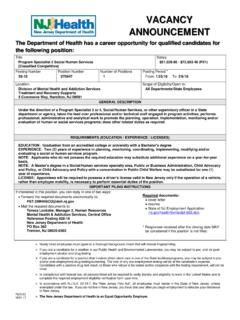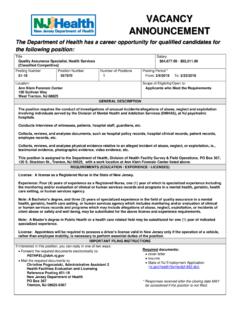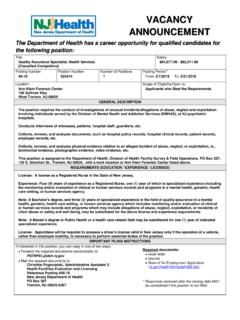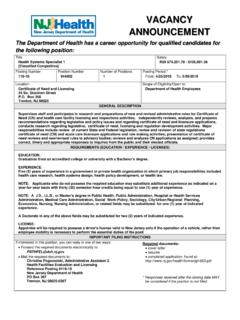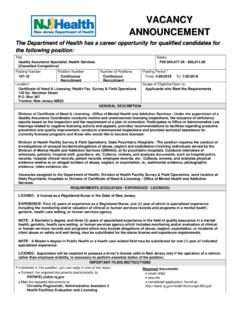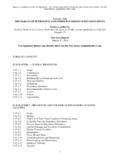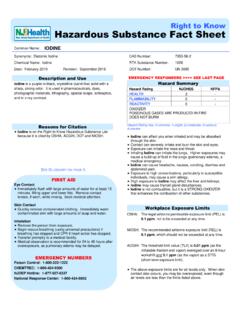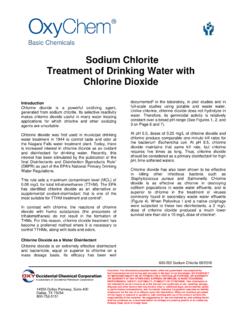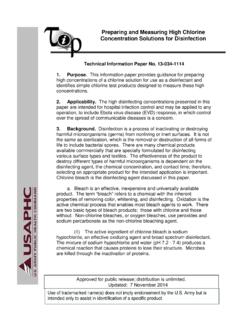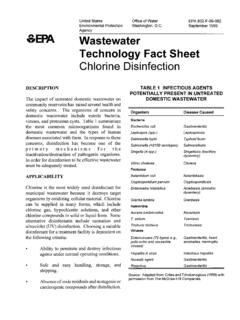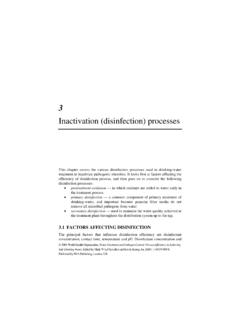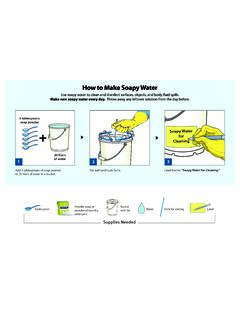Transcription of CHLORINE DIOXIDE HAZARD SUMMARY
1 Common Name: CHLORINE DIOXIDE CAS Number: 10049-04-4 DOT Number: NA 9191 (Hydrate, frozen) DOT HAZARD Class: FORBIDDEN (Not Hydrate) (Oxidizer) ---------------------------------------- --------------------------------- HAZARD SUMMARY * CHLORINE DIOXIDE can affect you when breathed in. * Contact can irritate the skin and eyes causing watery eyes and seeing halos around the lights. * Breathing CHLORINE DIOXIDE can irritate the nose and throat causing coughing and wheezing.
2 * Breathing CHLORINE DIOXIDE can irritate the lungs causing coughing and/or shortness of breath. Higher exposures can cause a build-up of fluid in the lungs (pulmonary edema), a medical emergency, with severe shortness of breath. * CHLORINE DIOXIDE is a HIGHLY FLAMMABLE and REACTIVE gas and a DANGEROUS FIRE and EXPLOSION HAZARD . * DOT regulations FORBID the transport of CHLORINE DIOXIDE in Not Hydrate form. IDENTIFICATION CHLORINE DIOXIDE is a yellow to red gas with an irritating odor similar to CHLORINE .
3 It is used to bleach wood pulp, textiles and oils, in processing flour, and for water purification. REASON FOR CITATION * CHLORINE DIOXIDE is on the Hazardous Substance List because it is regulated by OSHA and cited by ACGIH, DOT, NIOSH, DEP, IRIS and EPA. * This chemical is on the Special Health HAZARD Substance List because it is FLAMMABLE and REACTIVE. * Definitions are provided on page 5. HOW TO DETERMINE IF YOU ARE BEING EXPOSED The New Jersey Right to Know Act requires most employers to label chemicals in the workplace and requires public employers to provide their employees with information and training concerning chemical hazards and controls.
4 The federal OSHA HAZARD Communication Standard (29 CFR ) requires private employers to provide similar training and information to their employees. RTK Substance number: 0368 Date: June 1998 Revision: December 2005 ---------------------------------------- --------------------------------- * Exposure to hazardous substances should be routinely evaluated. This may include collecting personal and area air samples. You can obtain copies of sampling results from your employer. You have a legal right to this information under the OSHA Access to Employee Exposure and Medical Records Standard (29 CFR ).
5 * If you think you are experiencing any work-related health problems, see a doctor trained to recognize occupational diseases. Take this Fact Sheet with you. * ODOR THRESHOLD = ppm. * The range of accepted odor threshold values is quite broad. Caution should be used in relying on odor alone as a warning of potentially hazardous exposures. WORKPLACE EXPOSURE LIMITS OSHA: The legal airborne permissible exposure limit (PEL) is ppm averaged over an 8-hour workshift. NIOSH: The recommended airborne exposure limit is ppm averaged over a 10-hour workshift and ppm, not to be exceeded during any 15-minute work period.
6 ACGIH: The recommended airborne exposure limit is ppm averaged over an 8-hour workshift and ppm as a STEL (short term exposure limit). WAYS OF REDUCING EXPOSURE * Where possible, enclose operations and use local exhaust ventilation at the site of chemical release. If local exhaust ventilation or enclosure is not used, respirators should be worn. * Wear protective work clothing. * Wash thoroughly immediately after exposure to CHLORINE DIOXIDE and at the end of the workshift. * Post HAZARD and warning information in the work area.
7 In addition, as part of an ongoing education and training effort, communicate all information on the health and safety hazards of CHLORINE DIOXIDE to potentially exposed workers. CHLORINE DIOXIDE page 2 of 6 This Fact Sheet is a SUMMARY source of information of all potential and most severe health hazards that may result from exposure. Duration of exposure, concentration of the substance and other factors will affect your susceptibility to any of the potential effects described below. ---------------------------------------- ---------------------------------- HEALTH HAZARD INFORMATION Acute Health Effects The following acute (short-term) health effects may occur immediately or shortly after exposure to CHLORINE DIOXIDE : * Contact can irritate the skin and eyes causing watery eyes and seeing halos around lights.
8 * Breathing CHLORINE DIOXIDE can irritate the nose and throat causing coughing and wheezing. * Breathing CHLORINE DIOXIDE can irritate the lungs causing coughing and/or shortness of breath. Higher exposures can cause a build-up of fluid in the lungs (pulmonary edema), a medical emergency, with severe shortness of breath. Chronic Health Effects The following chronic (long-term) health effects can occur at some time after exposure to CHLORINE DIOXIDE and can last for months or years: Cancer HAZARD * According to the information presently available to the New Jersey Department of Health and Senior Services, CHLORINE DIOXIDE has not been tested for its ability to cause cancer in animals.
9 Reproductive HAZARD * There is limited evidence that CHLORINE DIOXIDE may damage the developing fetus. Other Long-Term Effects * CHLORINE DIOXIDE can irritate the lungs. Repeated exposure may cause bronchitis to develop with cough, phlegm, and/or shortness of breath. MEDICAL Medical Testing For those with frequent or potentially high exposure (half the PEL or greater), the following are recommended before beginning work and at regular times after that: * Lung function tests If symptoms develop or overexposure is suspected, the following is recommended: * Consider chest x-ray after acute overexposure.
10 Any evaluation should include a careful history of past and present symptoms with an exam. Medical tests that look for damage already done are not a substitute for controlling exposure. Request copies of your medical testing. You have a legal right to this information under the OSHA Access to Employee Exposure and Medical Records Standard (29 CFR ). Mixed Exposures * Because smoking can cause heart disease, as well as lung cancer, emphysema, and other respiratory problems, it may worsen respiratory conditions caused by chemical exposure.

